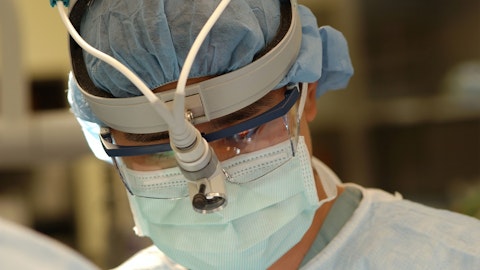Kevin Caliendo: Thanks for taking my question. If I go back to pre-pandemic days, with the Distribution and Solutions business. The company struggled to compete with sourcing from overseas, just because your costs were higher and the like. What are you anticipating now post all of this destocking inventory, your competitive position. Do you think that you’ll be able to compete? There was a lot of new business wins that were talked about because of your ability to source and manufacture onshore. And I’m just wondering what do you think the dynamics of the market are going to look like in six months from a competitive perspective, OMI fit into all this now with most of your manufacturer or a lot of your manufacturing anyways here domestically?
Ed Pesicka: Yes. So there’s a couple parts to that question. I think it’s important to answer. I said, you know, first, if I look back in our medical distribution division, one of the reasons why we’ve started to win new business and retain is part of — was really associated with we drastically improved our service. And if I look at 2017, 2018, 2019, our service levels in our distribution business were really poor and having corrected that has helped tremendously. You know, I think on the manufacturing side of it, that’s really partially what this operating model realignment is focused on. It’s looking at how do we strip cost out. I mean, we got to be transparent as in 2020 and 2021 and even in 2022, we’ve hedged down at as many resources as we can to produce as much product as we humanly possibly could to help save and help our customers out there.
We did that. Right now as we look at it, we’ve got of a cost structure issue, because of that as volumes have come down and it’s time to take those costs out. We probably haven’t done a great job during that period of time and as opportunities really around sourcing and looking at both not just pricing on what we pay, but also utilization and make sure how do we reduce yield scrap, as well as traditional scrap in our manufacturing facilities. And then, frankly, it’s — we’re going to take a hard look across the manufacturing facilities. What should we be making, what should we be sourcing and making sure that we are competitive both from a global standpoint, as well as our ability to produce the product to have control over that. So that’s really — it’s a fresh look at our — really our manufacturing footprint from start to finish or top to bottom and everyone look at it.
To make sure that we can be very competitive in the markets.
Kevin Caliendo: Okay. That’s helpful. Can I just ask one quick follow-up.
Ed Pesicka: Sure.
Kevin Caliendo: Following up on Mike’s question. Where do you think your leverage will be exiting 2023? And that we know where it is now, but sort of when you think about — we didn’t really talk about free cash flow or anything like that, but thinking about on December 31, where do you think your leverage will be at that point?
Ed Pesicka: At a high level, we think it’s going to be approximately one-turn lower between now and where we get to at the end of the year. Based on the achievement of the working capital that we’re going to take out of the business, the operating cash flow, as well as our ability to continue to pay down debt. Look, we had a strong quarter again in Q4 on debt pay down and cash flow. We expect that to continue throughout 2023 and ramp I should say as we go through 2023.
Kevin Caliendo: Great. Thank you so much.
Operator: The next question is from Lisa Gill with JPMorgan. Your line is open.




